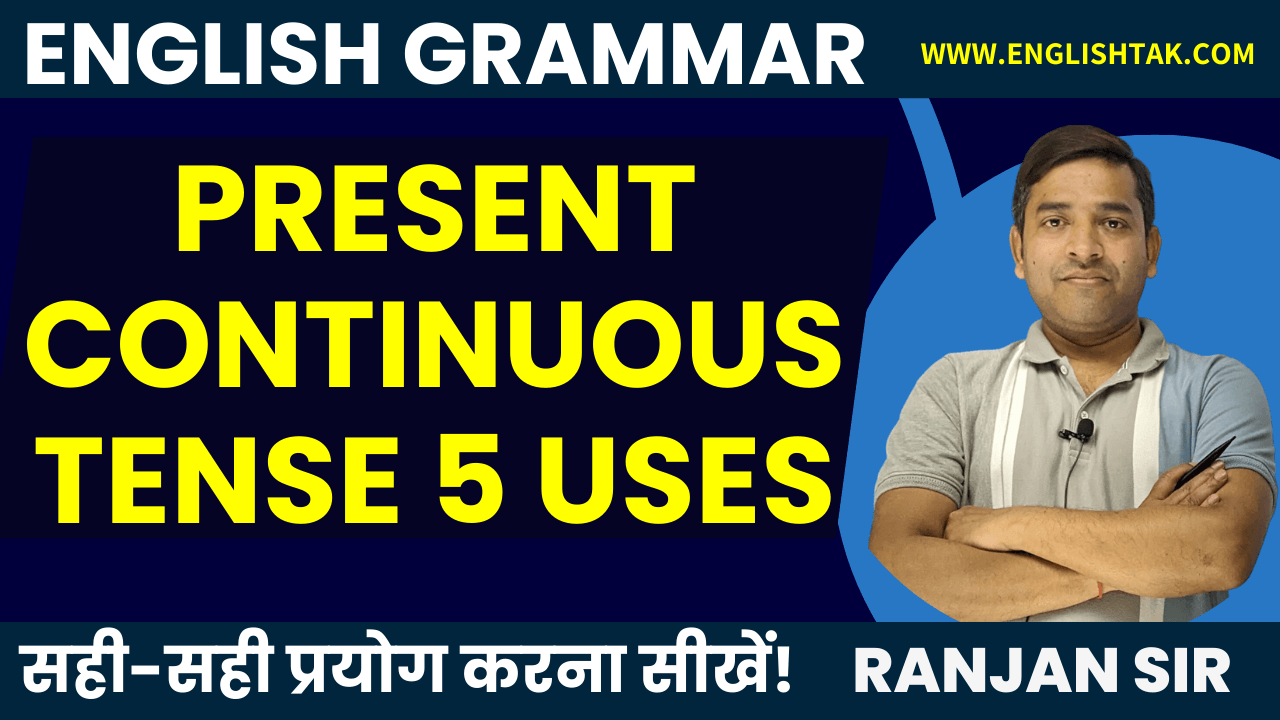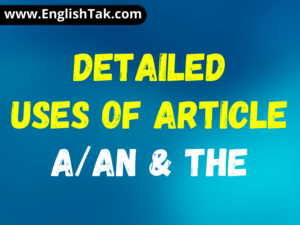![]()
Present Continuous Tense Rules and Uses
Present Continuous Tense Rules and Uses – The Present Continuous Tense plays a key role in describing various actions or situations that are either happening at the moment or are ongoing. Below are some of the main uses of this tense:
Present Continuous Tense Rules and Uses
Rule 1. Present Continuous Tense का प्रयोग तब किया जाता है जब हम किसी ऐसी गतिविधि के बारे में बात करते हैं जो वर्तमान समय में हो रही है, और अभी भी चालू है। यह क्रिया कुछ समय के लिए चल रही हो सकती है या थोड़ी देर में समाप्त हो सकती है। इसके अलावा, इसका उपयोग निकट भविष्य में होने वाली योजनाओं या बदलावों को व्यक्त करने के लिए भी किया जाता है।
Present Continuous Tense is used to indicate that an action is happening at the moment of speaking or around the present time and is incomplete or still in progress. This tense emphasizes that the action has started but has not yet been finished.
Example:
1. I am eating dinner right now.
मैं अभी खाना खा रहा हूँ।
(यहां “eating” से पता चलता है कि खाना खाने की क्रिया अभी हो रही है और पूरी नहीं हुई है।)
2. She is learning English these days.
वह इन दिनों अंग्रेज़ी सीख रही है।
(यहां “learning” से यह समझ आता है कि अंग्रेज़ी सीखने की प्रक्रिया जारी है।)
3. We are planning a trip for next weekend.
हम अगले वीकेंड के लिए एक यात्रा की योजना बना रहे हैं।
(यहां “planning” से यह संकेत मिलता है कि यात्रा की योजना अभी बनाई जा रही है और पूरी नहीं हुई है।)
More Examples:
1. वह सब्जी काट रही है।
She is chopping vegetables.
2. बच्चे फुटबॉल खेल रहे हैं।
The children are playing football.
3. सूर्य आकाश में चमक रहा है।
The sun is shining in the sky.
4. लड़कियां गाना गा रही हैं।
The girls are singing a song.
5. राजू अपने जूते पहन रहा है।
Raju is wearing his shoes.
6. सोहन मिठाई खरीद रहा है।
Sohan is buying sweets.
7. मैं आपको हिंदी सिखा रहा हूं।
I am teaching you Hindi.
8. वह इस समय सड़क पर चल रहा है।
He is walking on the street right now.
9. सीमा अभी फिल्म देख रही है।
Seema is watching a movie right now.
10. श्याम अपने बागीचे की देखभाल कर रहा है।
Shyam is taking care of his garden.
Rule 2. Present Continuous Tense का प्रयोग उन कार्यों के लिए भी किया जाता है जो स्थायी नहीं हैं बल्कि अस्थायी (temporary) हैं, और समय विशेष में हो रहे हैं। हालांकि वे कार्य उस समय हमारी आँखों के सामने नहीं हो सकते, फिर भी वे चल रहे होते हैं और वर्तमान काल में घटित हो रहे होते हैं। यह हमें यह बताने में मदद करता है कि कुछ ऐसा है जो एक सीमित अवधि के लिए हो रहा है, चाहे वह क्षणिक रूप से हो या थोड़े समय के लिए।
The Present Continuous Tense is also used for actions that are not permanent but temporary, and are happening during a specific period of time. Although these actions may not be happening in front of us at that moment, they are still ongoing and occurring in the present. This tense helps us express that something is happening for a limited duration, whether it is momentary or for a short period of time.
Examples
1. She is working on a new project these days.
वह इन दिनों एक नए प्रोजेक्ट पर काम कर रही है।
(यहाँ “working” यह दर्शाता है कि वह व्यक्ति उस समय हमारे सामने काम नहीं कर रही है, लेकिन वह प्रोजेक्ट पर अस्थायी रूप से काम कर रही है।)
2. They are staying in London for a few months.
वे कुछ महीनों के लिए लंदन में रह रहे हैं।
(यहाँ “staying” यह बताता है कि यह अस्थाई रूप से हो रहा है, लेकिन हमारी आँखों के सामने नहीं हो रहा है।)
3. I am reading a very interesting book these days.
मैं इन दिनों एक बहुत ही रोचक किताब पढ़ रहा हूँ।
(यहाँ “reading” इंगित करता है कि किताब पढ़ने की प्रक्रिया अभी जारी है, भले ही वह इस समय सामने नहीं हो रही हो।)
4. We are renovating our house this month.
हम इस महीने अपना घर नवीनीकरण करवा रहे हैं।
(यहाँ “renovating” यह बताता है कि घर का नवीनीकरण अस्थाई रूप से हो रहा है, और यह समय विशेष में किया जा रहा है।)
5. He is taking driving lessons these days.
वह इन दिनों ड्राइविंग की क्लासें ले रहा है।
(यहाँ “taking” दर्शाता है कि ड्राइविंग क्लासें अस्थाई रूप से चल रही हैं, लेकिन उस समय हमारे सामने नहीं हो रही हैं।)
Extra Examples:
1. वे किराए के फ्लैट में रह रहे हैं।
They are living in a rented flat.
2. मेरा भाई अब क्रिकेट पढ़ रहा है।
My brother is now studying cricket.
3. मैं इस समय उपन्यास पढ़ रहा हूं।
I am reading a novel at this moment.
4. श्याम स्कूल में पढ़ा रहा है।
He is teaching in the school.
5. वह इस महीने काम पर नहीं जा रहा है।
He is not going to work this month.
Note: ऊपर दिए गए वाक्यों से यह स्पष्ट होता है कि बोलते समय यह काम नहीं हो रहा है लेकिन उचित समय के आसपास हो रहा है।
Present Continuous Tense Rules and Uses
Rule 3. Present Continuous Tense का इस्तेमाल उस कार्य के लिए होता है जिसके निकट भविष्य में होने की योजना पहले से बनाई गई हो, यानी वह कार्य पूर्व-सुनियोजित है।
The Present Continuous Tense is not only used to describe actions happening right now but also to talk about future events that have already been planned or arranged. When we use this tense to refer to future events, it implies that there is a clear plan or arrangement in place, often involving another person or organization.
In this case, the action is not spontaneous but rather something we have already decided or discussed in advance. The time of the event is usually mentioned to clarify that it is a future plan.
Key Structure:
– Subject + am/is/are + verb (-ing form) + future time reference
Examples:
1. I am meeting my friend tomorrow.
मैं कल अपने दोस्त से मिल रहा हूँ।
(Here, “meeting” shows a plan that has already been made for tomorrow.)
2. We are flying to Delhi next week.
हम अगले हफ्ते दिल्ली जा रहे हैं।
(The use of “flying” indicates that travel plans have already been made for next week.)
3. She is starting a new job next month.
वह अगले महीने नई नौकरी शुरू कर रही है।
(The action of “starting” is scheduled to happen next month, showing prior planning.)
4. They are coming to our house for dinner tonight.
वे आज रात हमारे घर डिनर के लिए आ रहे हैं।
(The action of “coming” for dinner is a pre-arranged plan for tonight.)
5. We are going on vacation in December.
हम दिसंबर में छुट्टी पर जा रहे हैं।
(Here, “going” indicates that the vacation has already been planned for December.)
Extra Examples
1. मैं कल दिल्ली जा रहा हूं।
I am going to Delhi tomorrow.
2. तुम्हारा भाई कल घर आ रहा है।
Your brother is coming home tomorrow.
3. भारत के प्रधानमंत्री अगले महीने अमेरिका जा रहे हैं।
The Prime Minister of India is going to America next month.
4. मेरी बहन इस शाम गाने वाली है।
My sister is going to sing this evening.
5. वह कल ऑफिस के लिए निकल रहा है।
He is leaving for the office tomorrow.
Present Continuous Tense Rules and Uses
Rule 4. जब हम भविष्य में किसी कार्य को करने का इरादा व्यक्त करना चाहते हैं, तो हम Present Continuous Tense का उपयोग is/am/are + going to के साथ करते हैं। यह संरचना यह दिखाती है कि हम किसी कार्य को करने के लिए पहले से संकल्पित हैं या उसे करने की योजना बना चुके हैं। यह क्रिया भविष्य में होने वाली है, लेकिन इसका इरादा या फैसला वर्तमान में किया जा चुका है।
When we want to express the intention to do something in the future, we use the Present Continuous Tense with is/am/are + going to. This structure indicates that we are already determined or have made plans to do something. The action is going to happen in the future, but the intention or decision has already been made in the present.
Structure:
– Subject + is/am/are + going to + verb (base form) + Obj
Examples:
1. I am going to start a new course next week.
मैं अगले हफ्ते एक नया कोर्स शुरू करने जा रहा हूँ।
(यहां “am going to start” यह दिखाता है कि मैंने पहले से नया कोर्स शुरू करने का इरादा कर लिया है।)
2. She is going to visit her grandparents this weekend.
वह इस वीकेंड पर अपने दादा-दादी से मिलने जा रही है।
(यहां “is going to visit” बताता है कि दादा-दादी से मिलने का इरादा पहले से बना लिया गया है।)
3. They are going to move to a new house next month.
वे अगले महीने एक नए घर में शिफ्ट होने जा रहे हैं।
(यहां “are going to move” यह दिखाता है कि घर बदलने का फैसला पहले से लिया जा चुका है।)
4. English: We are going to buy a new car soon.
Hindi: हम जल्द ही एक नई कार खरीदने जा रहे हैं।
(यहां “are going to buy” यह संकेत करता है कि कार खरीदने का इरादा पहले से है।)
5. English: He is going to join the gym tomorrow.
Hindi: वह कल जिम जॉइन करने जा रहा है।
(यहां “is going to join” यह दिखाता है कि जिम जॉइन करने का निर्णय पहले ही लिया जा चुका है।)
Extra Examples:
1. मैं एक नया लैपटॉप खरीदने जा रहा हूं।
I am going to buy a new laptop. (इरादा)
2. वह अगले सप्ताह परीक्षा देने जा रहा है।
He is going to take the exam next week. (इरादा)
3. आज रात एक पार्टी होने जा रही है।
There is going to be a party tonight. (संभावना)
4. मैं इस महीने एक नई किताब पढ़ने जा रहा हूं।
I am going to read a new book this month. (इरादा)
5. वह अगले साल विदेश यात्रा करने जा रही है।
She is going to travel abroad next year. (संभावना)
Present Continuous Tense Rules and Uses
Rule 5. कुछ विशेष क्रियाएं हैं, जिनका प्रयोग Present Continuous Tense में नहीं होता। इनका प्रयोग Present Indefinite Tense में किया जाता है।
These verbs, often referred to as stative verbs, describe states, emotions, senses, or possession rather than actions that occur over time. Because they represent a static situation or a condition that doesn’t change rapidly, they are typically expressed in the Present Indefinite Tense rather than the Present Continuous Tense.
इन क्रियाओं को अक्सर स्थायी क्रियाएँ (stative verbs) कहा जाता है, जो किसी क्रिया की बजाय स्थिति, भावनाएँ, इंद्रियाँ, या स्वामित्व को व्यक्त करती हैं। चूँकि ये क्रियाएँ एक स्थिर स्थिति या ऐसी अवस्था को दर्शाती हैं जो तेजी से नहीं बदलती, इसलिए इन्हें आमतौर पर Present Continuous Tense के बजाय Present Indefinite Tense में व्यक्त किया जाता है।
Stative verbs do not indicate actions that are happening at the moment. Instead, they describe general situations, beliefs, or feelings that remain constant over time. Therefore, using these verbs in the continuous form would be incorrect in most cases.
Examples of Stative Verbs:
– See: I see the mountains from here. (Not: I am seeing the mountains.)
– Hear: She hears the music. (Not: She is hearing the music.)
– Like: He likes chocolate. (Not: He is liking chocolate.)
– Know: I know the answer. (Not: I am knowing the answer.)
– Have (to express possession): We have a car. (Not: We are having a car.)
Common Stative Verbs:
– Senses: see, hear, smell, taste, feel
– Emotions: love, hate, like, dislike, prefer
– Mental states: know, believe, understand, hope, accept, admit, realize, trust
– Possession: have, own, belong, contain
– Appearance/States of being: seem, look (when not referring to physical actions)
These verbs describe static conditions rather than ongoing activities, which is why they generally don’t appear in continuous forms.
Examples:
1. Present Indefinite: I know the answer.
Present Continuous (Incorrect): I am knowing the answer.
2. Present Indefinite: She loves her family.
Present Continuous (Incorrect): She is loving her family.
3. Present Indefinite: We have a large house.
Present Continuous (Incorrect): We are having a large house.
4. Present Indefinite: They believe in hard work.
Present Continuous (Incorrect): They are believing in hard work.
5. Present Indefinite: This soup tastes delicious.
Present Continuous (Incorrect): This soup is tasting delicious.
English Grammar in Hindi
Present Continuous Tense Rules
Tenses Fill in the Blanks Exercise Set-10
Sentences of Past Perfect Tense in Hindi and English
Prepositions in English Grammar in Hindi
600+ Fixed Preposition with Hindi Part-2





